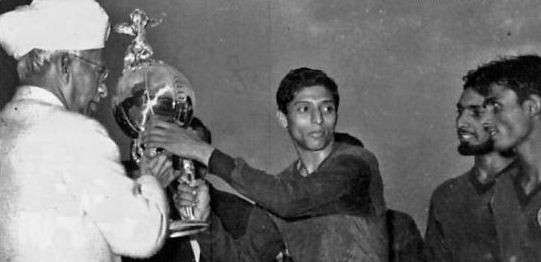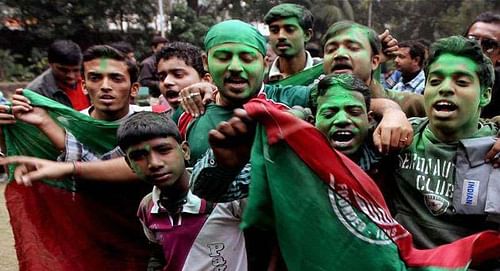
Bagan's no bygone: The illustrious history of 'India's national club' is why they deserve that tag
The oldest club in Asia. The club which has had a huge part to play in shaping the course of Indian football through history and the club which is central to the ethos of lakhs of devoted fans in Bengal, forming one-half of what is one of the biggest derbies in world football against East Bengal. We’re talking about the legendary institution of Mohun Bagan, of course.
To the ‘noveou riche’ in the initiation to what is the complex world of Indian football, East Bengal might just be the name of a club in the now much less celebrated I-League. But Bagan are seminal to whatever football culture exists in India right now. For without them, the game would not have gained the popularity that it did initially in the 1950’s and 1960’s.
Spawned out of the desire to infuse competitive spirit in the Bengali youth in 1889, Mohun Bagan (literally meaning sweet group in Bengali) quickly established itself as one of the top clubs in the country along with fellow city rival Mohammedan Sporting. Till date, it is the most successful club in the country in terms of trophies won and fostering a rich tradition of football.
Placing a high emphasis on physcial fitness was an ethos that Bagan followed in the second decade of its existence, and this slowly began to reap rewards as the slowly began to win all national tournaments in the country like the Coochbehar Cup, Trades Cup and Gladstone Cup.
This was the time when there were many prestigious tournaments in the country and the football scene was not dominated by a single national league and lasted only about a few months to make up a football calendar of various different tournaments totalling 8 months.
Arguably, Bagan’s watershed moment came when they defeated East Yorkshire regiment (an English team of British personnel based in India) in the final of the most prestigious tournament – the IFA shield – in 1911 in Calcutta. It was seen as a symbolic victory over the oppression of the British rule, and furthered the fervour of nationalism in the youth of Bengal.
The 2-1 victory was even hailed in the English press, The Manchester Guardian describing Bagan as “a team of Bengalees” and East Yorkshire regiment as “a crack British regimental team”.
Then in the 1910’s, Bagan gave rise to a player who would go on to become the first player who was truly recognised all over the country and became a pioneer in his position on the pitch – Gostha Pal. He was only 17 years of age when he made his debut in 1913, but his class was apparent from that early age.
A fierce physical aspect in his game held him in good stead against taller British officers, and he went on to form a formidable defensive partnership with another very talented defender, Bhuti Sukul. They would be cogs in a team that went on to be called “The Formidables”.
There are very few people who would truly be in a position to speak with nostalgic knowledge of the club through the middle of last century, and Soumyajit Bhowmick, a lifelong Mohun Bagan supporter from the 1930’s is one of them.
“Those were different times”, he says. “The club oozed of class and aristocracy, but yet would be an instrument of social fervour among Bengali youth. The values it held about football and how it could be a tool to build a strong identity remain in the club till this very day. Even though there have been a lot of changes on the pitch and off the pitch, Mohun Bagan is still the national football club of India.”
Formerly also a member of the board of directors of the club, Bhowmick opines that the most influential footballer to be produced by the club was Sailen Manna. Thus Mohun Bagan also gave India its very first ‘firsts’ in Indian football. First superstar in the form of Gostha Pal, first legendary player in the form of Sailen Manna, and first team to dominate the Indian football landscape.
In fact, it is said that at his peak, Sailen Manna could have been a world-class defender in any European League, and had the opportunity been there it would have been tempting for football fans in India to see where he stood in comparison to the so-called guardians of the game in Europe.
Then came Chuni Goswami in 1954, a fantastic dribbler who had come through the ranks of the Mohun Bagan youth academy, immediately leaving his presence felt on the senior team. He went on to have a glittering career, also being a part of the Indian team which won gold in the Asian Games, and subsequently regarded by many as the greatest Indian footballer of all time, even ahead of the likes of IM Vijayan and Bhaihung Bhutia.

And then came Pele.
Pele, the greatest footballer of all time graced Calcutta in 1977 and played Mohun Bagan in front of 80,000 spectators at Eden Gardens, as part of American club side New York Cosmos. The fact that Cosmos (albeit not a world renowned club but having a truly world-class player in their side like Pele) decided to come to Calcutta to play in the friendly is a big testament to the size of the club that Mohun Bagan is.
In what was a commendable effort, they even drew 2-2 against the Cosmos, while being unlucky to let slip a one-goal lead at 2-1. It was on Pele’s advice that the Cosmos management decided to come to India, after his agent received a letter stating Mohun Bagan’s role in India’s independence and ended with an appeal to the “Black Pearl” – that the country of Mahatma Gandhi, was eagerly waiting for him.
In fact, on Pele’s last trip to India to promote the Subroto Cup, he made a mention of the hospitality shown to him by Mohun Bagan, and he hoped that his visit in 1977 worked as a catalyst to increase the popularity of the sport in India.
Bhowmick testifies to that, maintaining that Bagan has always been a “classy” club. “We were very aristocratic and elite from the beginning. We had a certain way of doing things, and when we did them it would leave a really good impression. That’s what it’s all about – ensuring the processes and principles are in order, and building something sustainable for the future.”
And build something for the future they did. Among more firsts, Bagan became the first Indian club to play at the Asian level by taking part in the 1987 Asian Club championship. They played well, but finished second in their group and were thus unable to qualify for the semi-finals of the tournament.
Soon after in 1989, during the centenary celebrations of the club, it was declared the “national club of India” by the Prime Minister Rajiv Gandhi and became the first club to be honoured by the Government of India by issuing their own unique postage stamp.
In the modern era of Indian football, Bagan continues to be one of the clubs at the forefront. Two seasons back, they won their first I-League title in dramatic fashion towards the end of the league, by drawing with Bengaluru FC in their last match to clinch the title.
Players like Katsumi Yusa and Jeje Lalpekhlua are central to the success of Mohun Bagan in the years to come, and even though the future of the I-League seems bleak, it is believed that Bagan would be one of the clubs which would be merged into the fold of the Indian Super League. For the sake of a rich footballing legacy and many more triumphs in the future, it is certainly hoped so.
